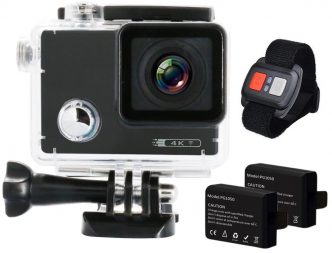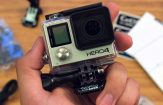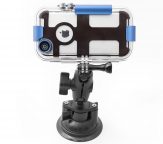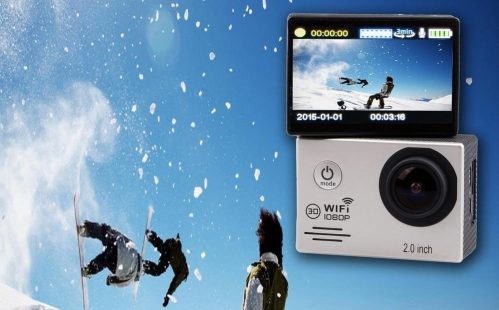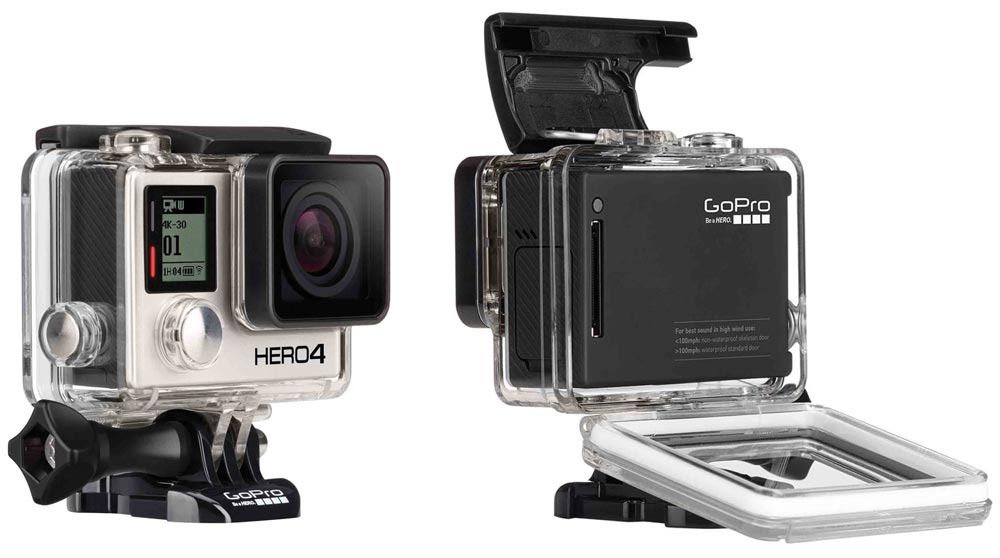 Last year, with the release of the film, Hardcore Henry (which was shot entirely with GoPro cameras in first person perspective), we decided that we were going to look at the different cost-effective sport and mobile cams on the market to see which ones were worth investing in for our readers.
Last year, with the release of the film, Hardcore Henry (which was shot entirely with GoPro cameras in first person perspective), we decided that we were going to look at the different cost-effective sport and mobile cams on the market to see which ones were worth investing in for our readers.
The gold standard in this market has been GoPro, who kindly provided us with one of their HERO4 Black cameras for this extended research article.
[The recently released HERO5 Black is not covered here due to the length of this extended testing period, but it has almost identical specifications for video recording—with the main changes being a physical redesign that includes a built in video touchscreen, Optical Image stabilizer, and waterproofing for up to 10 meters without accessories.]
Along with this, we looked at some of the budget sport cams including the Lightdow LD6000 and Allwinner F60R. (A number of the newer action cam companies were contacted, as well, and, although they were initially willing to be part of our shootout, opted out when they realized their products would be directly compared with the HERO4 Black.)
Additionally, since many of our readers have been stating that they’ve been keeping their older iphones to use as ad hoc action cams due to the high quality of the Apple cameras and the availability of numerous mounting accessories, we also explored the iPhone 4S, 5S, and 6S Plus.
For parameters, we decided that the 13 most important things to consider were: Frame Rate Options, Resolution, General Image Quality, Low Light Sensitivity, Field of View, Preview Screens, Remote Preview, Battery Life, Audio Quality/Options, Sturdiness, Storage/Expandability, Accessories, and Cost.
[Note: We didn’t explore how the waterproofing levels compared (considering all of these cameras are not natively waterproof and require special cases for them) or Optical Image Stabilization (since, of the ones we looked at, only the iPhone 6S Plus has that).]
As shootouts tend to drift into pages of tech babble which is meaningless to most readers, we’re aiming to keep all of the info here extremely pertinent to a direct comparison, with a winner declared for each section, and a combined total winner announced at the end with our final thoughts as to why.
If you’d like to read through the official stats from the company websites: AllwinnerTech (Translated)| Lightdow LD6000 page (More info at their tech manual)| GoPro | iPhone .
Frame Rate Options
While some of these will do additional frame rates, we focused on the fastest frame rates they’re able to record.
The iPhone 4S maxes at 30 FPS regardless of 720P or 1080P resolution; the LD6000 maxes at 60 fps at 720P, but just 30 at 1080P; the F60R and iPhone 5S can both do 60 fps in 1080P and 120 fps in 720P; finally, the HERO4 Black and iPhone 6S Plus both can record 120 fps in 1080P or 240 fps in 720P.
Due to the ease of switching back and forth between frame rates, previewing higher frame rates, and exporting out clips in the apparent frame rate you want from the camera, the iPhone 6S Plus is the winner here.
Resolution
All the cameras maxed out at 1080P with the exception of the F60R, HERO4 Black, and iPhone 6S Plus, which all recorded 4K at 30fps. (The HERO4 Black can also record 4K at 24fps and 25fps, as well.) The HERO4 Black, however, gives you a lot of additional resolution options (including anamorphic wide angle) at 4K, 2.7K, 1440P, 1080P, 960P, 720P, and SD (WVGA).
The HERO4 Black was the clear winner in resolution options.
General Image quality
In bright days, I was really surprised by how good the image quality was on both the LD6000 and the F60R, where their quality was almost as good as the iPhone 4S/5S. However, in non-ideal lighting, the image got muddy and grainy pretty quickly for these two.
The iPhones general quality was extremely high, with the iPhone 6S Plus having the best image quality in general of this line. The fact that there’s no distortion to the image could have made an argument for giving the iPhone 6S Plus the win in the best General Image quality.
The HERO4 Black was able to grab extremely crisp, clear images right out of the box and, because it uses lower compression on its video files than the other cameras, you can also do more to adjust GoPro footage in post than the other cameras. Although some distortion removal is required in post for most of the GoPro footage, the quality achieved made this a very worthwhile trade.
As such, the HERO4 Black was the winner in General Image quality.
Low Light Sensitivity
When it came to low light sensitivity, things got really, really divergent. To run our tests here, I decided to take the cams into the professional audio studio of Oakwood Sound Studios outside Lexington, KY. These studios use a very soft LED and incandescent lighting that’s extremely soothing to the eyes for long periods, but which the human eye must dilate to adapt to—something that cameras are notoriously bad at doing.
Both the LD6000 and the F60Rs recorded images that were drastically degraded in this situation, with a lot of noise showing up and only the brightest spots (like monitors and a direct shining Fresnel) showing up with any clearness in the frame.
The iPhones were a little better, but only the iPhone 6S Plus was able to adapt to any sort of potentially useable image, and even that was very dark and murky.
The HERO4 Black, however, recorded such a clean image that it almost looked like I had properly lit the set, which was jaw dropping.
When we did tests in evening, city illuminated nights, and other low-light situations, the results were very similar. While the iPhones did a lot better in this area than I expected them to—especially the iPhone 6S Plus–the HERO4 Black was the one that really shone.
As such, the HERO4 Black was the clear winner here.
Field of View
Field of View refers to how wide the perspective of a viewing device is, with more degrees representing a wider area. These are normally measured in diagonal degrees, which are pretty useless for comparing to the 35mm photography lenses you’re used to using in your video DSLRs. As such, I’ll give you some rough comparisons with the benchmark 35mm-style lens being a 50mm lens (which is approximately what the human eye sees).
As an FYI for those not familiar with 35mm lenses, smaller numbers in millimeters actually mean a wider area that the lens sees, while higher numbers in millimeters means a smaller area that the lens sees, so an 80mm lens is thought of as a zoom lens because it focuses on a smaller amount of scene, while a 15mm lens is a fish eye lens because it focuses on a larger amount of a scene, warping the image to do so like the curvature in the eye of a fish.
The F60R and LD6000 have a fixed lens with a diagonal FOV of 170 degrees, which is approximately the same as a 15mm fisheye lens. While you can use plugins after the fact to minimize the fish eye distortion, you’re stuck with that wide angle fish eye effect as far as your original footage goes.
The iPhones we looked at also have fixed lenses, but these use rectilinear lenses which don’t distort things. This prevents them from capturing as wide a shot, but it also removes the processor intensive need to remove distortion from the footage. With diagonal FOVs in the 55 – 65 degree range, the iPhones are between 30-33mm in effective comparison, which is a little wider than the human eye normally sees, but not a lot.
By default, the HERO4 Black starts with a 149 degree FOV fisheye lens, which translates to a 17mm fisheye, which gives you a little less distortion (and a little smaller field of view) than the F60R or the LD6000. The following video from Behind The Looking Glass Films shows the stock differences between the iPhone’s rectilinear lens and the GoPro fish eye lens field of view in 4K:
Unlike the other competitors we observed, however, the HERO4 Black gives you quite a few more options, as well.
For resolutions of 2.7K and below, you can essentially have the camera crop into part of the image being recorded and minimize how wide an angle the shot is, which in turn also minimizes part of the fish eye distortion. The lower the resolution of the image you’re shooting (at least down to 720P, as the ones below that go back to ultra wide), the more options you’ll have for zooming in. The narrowest field of view you can achieve is about 74 degrees, which is approximately the same as a 35mm camera lens. (This is a little wider than the human eye normally sees and results in much smaller amount of distortion.)
The wide range of Field of View options made the HERO4 Black the winner here.
Preview Screens
All but the HERO4 Black had a preview monitor built in, with the iphone preview monitors being the highest quality (as well as being touch screens, which neither the F60R or LD6000 had). Additionally, the fact that the iPhone 5S and iPhone 6S Plus both allow you to have a live preview while recording in higher frame rates as you’re recording is especially useful.
The iPhone 6S Plus, with its larger touchscreen, was the winner here.
Remote Preview
Even though the HERO4 Black lacked a monitor, its app made viewing what the camera saw quite easy in a smartphone whenever you’re shooting in a standard 24 or 30 fps frame rate, as well as the less common 48 fps; any higher frame rates, however, resulted in no preview ability while the camera was actually recording, unfortunately.
The LD6000 and F60R also had app software for remote viewing, but it had a lot fewer options than the GoPro app had.
While Iphones aren’t intended for remote preview, per se, some companies do seem to be developing apps for this use and I suspect we’ll see a lot more of these in the years to come. (Currently, Blux Camera/Blux Lens is a non-US app system we found in the course of this article, but it’s not able to be accessed by U.S. citizens. Commander Camera is a new one that is available on the U.S. app store, as well, although it was too new for us to be able to test with this article.)
Although the combination of both preview screen and remote preview would likely give the edge to the LD6000 and F60R, based solely on the remote preview options, the HERO4 Black is definitely the winner. (I just do wish they’d give you a drop-frame preview for the higher frame rates in future versions, however.)
Battery Life
HERO4 Black battery life is directly related to your resolution (more than your frame rate) with actual record time for a single battery being between 45-50 minutes for 30fps 4K to as much as an hour and a half for most of your 720P recording options.
The LD6000 and F60R have similar battery capacities to the HERO4 Black, with between 40 (at higher resolutions) to 95 minutes of recording (at 720P).
Apple lists their battery consumption for video usage for the iPhone 4S and iPhone 5S as up to 10 hours and for the iPhone 6S Plus as up to 14 hours. The actual usage time for video recording purposes (if your viewscreen stays on at 50% brightness) is more like 3.8 hours for iPhone 4S/iPhone 5S and 5 hours for the iPhone 6S Plus. (Unfortunately, the iPhones don’t let you swap out batteries, so there’s not the option to be cycling batteries so you can continue shooting.)
The winner here is the iPhone 6S Plus.
Audio Quality/Options
When just recording from the onboard microphones, the quality of the audio was fairly muddy with the LD6000 and F60R; pretty clear (and pretty similar) with the HERO4 Black, iPhone 4S, and iPhone 5S; surprisingly clear on the iPhone 6S Plus.
(Obviously, you wouldn’t be recording movie dialogue with an onboard mic of any form, but this gives you an idea of what you can expect for wild sound you record. All cameras recorded audio clearly enough to sync properly with secondary sound recording system.)
When it came to options to enhance your recording audio with a microphone directly, neither the LD6000 nor the F60R had a way to plug in an external microphone, so you’re stuck with just their onboard microphone for raw sound. The HERO4 Black has an optional 3.5 mm mic attachment for $50, which will let you plug in any non-phantom powered microphones that can fit that plug (like most of the ones designed for video DSLR cameras). The three iPhones looked at each had 3.5mm input/output jacks included without any additional attachments required.
The winner in this area is the iPhone 6S Plus.
Sturdiness
We went through a lot of work to test how sturdy these cameras were, taking them to events like dance parties in night clubs, through teaming comic and game conventions, and to high impact karate classes.
While none of them broke under our use, I did find that the construction on both the F60R and the LD6000 didn’t leave me feeling that they would hold up as long as the other products. While the iPhones were pretty rugged (with the iPhone 5S actually feeling the sturdier than the iPhone 6S Plus), I was surprised by how well the HERO4 Black was put together.
While the HERO4 Black wouldn’t survive as long without its case as the iPhones, none of these cameras could actually be used for action camera purposes without a case and binding, so that’s a bit of a moot point. With the case and its internal build, it felt like the HERO4 Black would actually last the longest (which is even more impressive when you think of the fact that the GoPro cameras were initially thought of as being disposable by the television and film crews that used them).
The HERO4 Black was the winner in the Sturdiness challenge.
Storage/Expandability
All three of the action cams supported microSD cards, which could be switched out fairly easily and quickly, while none of the iPhones do (which means you’re stuck with however much storage you have until you can download it from the phone hard drive to your computer).
Of the action cams, neither the F60R and LD6000 worked well with the fastest microSDXC UHS cards, whereas the HERO4 Black did. Additionally, the HERO4 Black has additional functionality for downloading files from the camera to your wifi or bluetooth enabled smart device, which gives you additional options for when you swap out cards.
The HERO4 Black was the winner in the Storage/Expandability challenge.
Accessories
The Lightdow LD6000 includes a medium accessory kit including: waterproof case (up to 30m), clip case, bicycle stand, helmet base, bandage strap, 4 different bases, 3 different switch supports, ribbon holders, adhesive tape, a batteries, and a charger cable. The F60R came with all the same accessories as the LD6000, but also includes a 2.4ghz remote (waterproof up to 10 m) and wrist strap, which is very cool. Virtually all GoPro Hero accessories released between the original Hero and HERO4 will work with these cameras, with the exception of the batteries (which flip the polarity so you can’t use them with one another).
The HERO4 Black includes a waterproof case rated to 40 feet (with a replaceable “skeleton” door so you get better audio recording when you’re not in the water), rechargeable battery, curved and flat adhesive mounts, Quick Release Buckles, 3-way Pivot arm, and a USB data/charging cable. Obviously, there are a ton of 3rd party accessories you can get for this, since GoPro is the originator of action cams.
The iPhones include a usb plug, a usb charging/data cable, and a hands free mic headset, but have a lot of options for after market mounts you can get thanks to the growth of the iPhone filmmaking market and the use of kickstarter for new entrepreneurs there.
The winner here is the F60R (although it should be noted that none of these accessory kits includes an actual mount for a tripod, so, if you’re going to ever put one of these on a traditional set of sticks or a monopod, you’ll want to pick that up separately).
Cost
The Lightdow LD6000 is available for around $50 online at sellers like Amazon.
The Allwinner F60R has an official MSRP of $183, but is regularly sold online for prices ranging between $45-$55.
If you are going to be purchasing iPhones directly for camera purposes (rather than transitioning from iPhones you already owned for newer ones) then, as of the time of this writing, the 6S Plus is going to start at $649, with Apple certified refurbished versions of the similar 6 Plus running $450.
Obviously, older refurbished iPhones are cheaper, with the 5S refurbs fetching prices between $100 – $150 and the 4S refurbs running between $80-$120.
The GoPro HERO4 Black is still available on Amazon for less than $350. (The follow up version, the HERO5 Black, has an MSRP of $399 . While they’ve done away with some of the other color-coded models for the HERO5 line, they do have a smaller cube-shaped version called the HERO5 Session, which also has image stabilization, will do 4K at 30 fps, and 1080P at up to 90 fps for $299.)
The winner in pure cost to purchase is the F60R, while the winner in cost vs. options is the HERO4 Black.
Final Analysis
I was actually really surprised by how well all of the cameras we looked at acquitted themselves (especially for their price points).
With that said, while the iPhone 6S Plus fought a hard fight with its large touch screen and audio accessory port, its size and format make it less readily usable and its higher cost make it something you’d be less likely to put into harm’s way.
With that said, the GoPro HERO4 Black is the one that does all the things you want a good action camera to do, with a small enough form to be easily strapped to unusual places, a sturdy build that makes it less likely to get broken, a shocking number of options for frame rates and resolutions, and a best in class low-light sensitivity so that you get that perfect shot of fireworks reflecting off the hood of your car as you drive through a night city on the Fourth of July. In our opinion, this is definitely the way to go.
The new GoPro HERO5 Black seems to have even more going for it than its predecessor if the Image Stabilization is good (although its redesign does mean that you’ll have to get aditional new accessories if you’ve been using action cams for a while).
For folks who might be thinking of buying older models of HERO cameras, you can see a comparison of the different HERO chipsets in image quality in this video from Mic Bergsma:
Have you tried out any of these cameras–or other cameras that we missed? Leave your comments about your experiences below.

